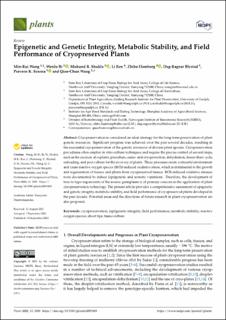Epigenetic and Genetic Integrity, Metabolic Stability, and Field Performance of Cryopreserved Plants
| dc.contributor.author | Wang, Min-Rui | |
| dc.contributor.author | Bi, Wenlu | |
| dc.contributor.author | Shukla, Mukund R. | |
| dc.contributor.author | Ren, Li | |
| dc.contributor.author | Hamborg, Zhibo | |
| dc.contributor.author | Blystad, Dag-Ragnar | |
| dc.contributor.author | Saxena, Praveen K. | |
| dc.contributor.author | Wang, Qiao-Chun | |
| dc.date.accessioned | 2022-02-24T10:02:18Z | |
| dc.date.available | 2022-02-24T10:02:18Z | |
| dc.date.created | 2022-01-05T11:28:08Z | |
| dc.date.issued | 2021-09-13 | |
| dc.identifier.citation | Plants. 2021, 10 (9), . | en_US |
| dc.identifier.issn | 2223-7747 | |
| dc.identifier.uri | https://hdl.handle.net/11250/2981147 | |
| dc.description.abstract | Cryopreservation is considered an ideal strategy for the long-term preservation of plant genetic resources. Significant progress was achieved over the past several decades, resulting in the successful cryopreservation of the genetic resources of diverse plant species. Cryopreservation procedures often employ in vitro culture techniques and require the precise control of several steps, such as the excision of explants, preculture, osmo- and cryoprotection, dehydration, freeze-thaw cycle, unloading, and post-culture for the recovery of plants. These processes create a stressful environment and cause reactive oxygen species (ROS)-induced oxidative stress, which is detrimental to the growth and regeneration of tissues and plants from cryopreserved tissues. ROS-induced oxidative stresses were documented to induce (epi)genetic and somatic variations. Therefore, the development of true-to-type regenerants of the source germplasm is of primary concern in the application of plant cryopreservation technology. The present article provides a comprehensive assessment of epigenetic and genetic integrity, metabolic stability, and field performance of cryopreserved plants developed in the past decade. Potential areas and the directions of future research in plant cryopreservation are also proposed. | en_US |
| dc.language.iso | eng | en_US |
| dc.publisher | MDPI, Basel, Switzerland | en_US |
| dc.rights | Navngivelse 4.0 Internasjonal | * |
| dc.rights.uri | http://creativecommons.org/licenses/by/4.0/deed.no | * |
| dc.title | Epigenetic and Genetic Integrity, Metabolic Stability, and Field Performance of Cryopreserved Plants | en_US |
| dc.type | Peer reviewed | en_US |
| dc.type | Journal article | en_US |
| dc.description.version | publishedVersion | en_US |
| dc.rights.holder | © 2021 by the authors | en_US |
| dc.source.pagenumber | 19 | en_US |
| dc.source.volume | 10 | en_US |
| dc.source.journal | Plants | en_US |
| dc.source.issue | 9 | en_US |
| dc.identifier.doi | 10.3390/plants10091889 | |
| dc.identifier.cristin | 1975006 | |
| dc.relation.project | Norges forskningsråd: 255032 | en_US |
| dc.source.articlenumber | 1889 | en_US |
| cristin.ispublished | true | |
| cristin.fulltext | original | |
| cristin.qualitycode | 1 |
Tilhørende fil(er)
Denne innførselen finnes i følgende samling(er)
-
Divisjon for bioteknologi og plantehelse [523]
Publikasjoner knyttet til ansatte ved Divisjon for bioteknologi og plantehelse -
Publikasjoner fra CRIStin - NIBIO [4531]
-
Vitenskapelige artikler [1416]

